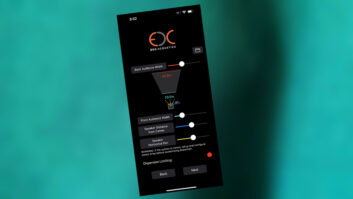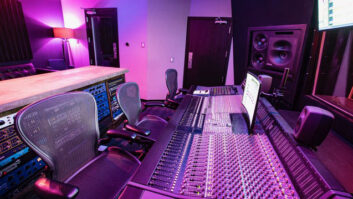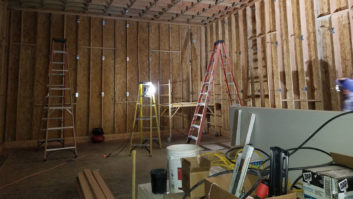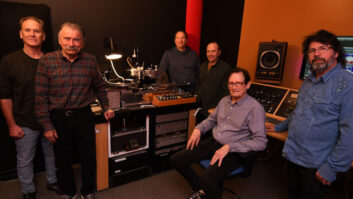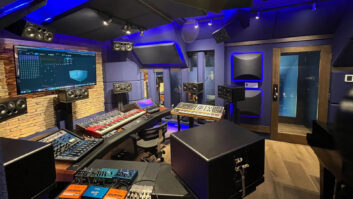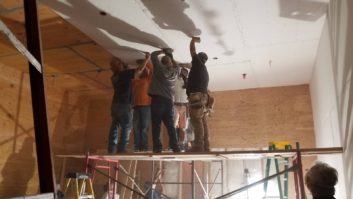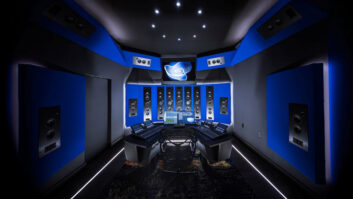A woman. Her preteen daughter. A giant old Manhattan brownstone. A rainy night. Three dangerous thugs want something valuable inside the house and will go to almost any lengths to get it. These are the main elements that make up the simple story told in director David Fincher’s latest exercise in nerve-shattering suspense, Panic Room. It’s Straw Dogs in the big city; Home Alone definitely not for kids. With Panic Room, Fincher — whose credit list is dominated by intense, violent action dramas such as Alien 3, Seven, The Game and Fight Club — has created a film that deals with different levels of real and psychological terror, and an ever-escalating battle that consumes the four-story house with a vault-like “Panic Room” at its core. The film is a thrill ride, pure and simple, designed to disturb as much as delight; that’s been Fincher’s M.O.
From a technical standpoint, Panic Room is very interesting, with the entire film taking place in and around a single building. The house is very much a leading character in the film, and Fincher and his crew have gone to great lengths to give each room or hallway its own visual and sonic personality and characteristics, much as a haunted-house movie revels in the creepy differences between one dimly lit chamber and another. This isn’t horror fantasy, however; it feels frighteningly real, and it plays on our primal fears about freedom, security and family.
Sound plays a key role in the film, too, what with all the lurking and tiptoeing and creaking floors, the relentless rain, slamming doors, shattered windows and assorted violent calamities. Going into the project, Fincher’s longtime sound designer/supervising sound editor Ren Klyce says he believed it might be a fairly straightforward job, but he quickly discovered otherwise.
“This film takes place inside a house, all in one evening,” Klyce says during a break at Skywalker Sound, where the film was being mixed. “And when you read the script or watch a rough cut of it without anything added in, it seems like, ‘Oh this will be pretty easy to do. All you need is some rain and some hard effects here, and the panic room door, a gun — easy.’ But it turned out to be very complicated and very difficult; in fact, it was one of the hardest things I’ve ever worked on. I think that part of the challenge in keeping being stuck inside of a house for two hours interesting is that you really have to reach for the subtle little nuances to keep your ear engaged.”
SOUND FROM THE SET
Rather than trying to find the perfect building in New York City, Fincher had one constructed to his specifications on Sony’s Manhattan Beach (California) lot, at an estimated cost of more than $8 million. “This isn’t just some set, either,” Klyce says. “It’s a four-story house, completely built, with 18-foot-high ceilings on practically every floor. It was absolutely wonderful from a sound perspective. All the doors are solid wood core. All the walls are solid. I’ll never forget when he was showing me the set for the first time, he said, ‘Look, we put floor creaks in, just for you!’ And they did, which was great. I don’t know how they did that, but I’m glad they did.”
Building the house from scratch gave Fincher, Klyce and cinematographer Conrad Hall Jr. much more control than they would normally have on a location shoot. In fact, Klyce notes, “Fincher pre-visualized the film in a computer before they started filming. They designed the building and they put the architectural plans in to this CAD-type program, and then he could film virtually in the house and figure out in advance which lenses he would need for which shot, how much track they’d need to run for doing this tracking shot, or if they needed to remove a wall to get the camera back a bit.
“The camera is like a character in this film,” Klyce continues. “If you look at, say, a Spike Jonze film [Klyce worked on Jonze’s Being John Malkovich], where the camera is handheld, it has a very different feel from something that’s staged, like a Jim Jarmusch film, where he puts the camera on a tripod, turns it on and presents a scene. What Fincher’s trying to do is the best of both worlds. He wants the intimacy and spontaneity of handheld photography, but with the accuracy and precision of a dolly move. It ends up being a choreographed dance between the actors and the camera crew. For example, when an actor bends down to the ground, the camera moves with the actor in perfect sync. Not anticipating his move, not lagging behind his move, but exactly with his move, to the point where you don’t notice the camera moving at all. To get this right, unfortunately, takes a lot of time and many takes. So they had billions of takes,” he says with a laugh. “I’m exaggerating, but typically Fincher would shoot anywhere between 10 to 30 takes…sometimes 40.”
The fact that the film was shot in such a tightly controlled environment was not enough to prevent a number of problems from creeping up during production. “For one thing,” Klyce says, “they had a rain machine going constantly, which completely and drastically affected our [production] sound. It was quite hissy. Then, he had Panavision modify their cameras to operate on three-perforations per frame rather than four-perferations. Knowing that the camera moves were going to be quite elaborate, he wanted to get the most amount of time per roll. Because three perfs requires one less perf per frame, he could get 20 percent more time per reel, which saved the production hundreds of thousands of dollars in film stock. The three-perforation innovation was fantastic, but because of the modification, the cameras started making a horrible whirring noise at about 500 feet into the magazine. No matter what they did — sound blankets, what have you — the crew couldn’t get rid of that sound. Whirrrrrrrr. And to make matters worse, the whirring noise wasn’t constant. We couldn’t find the perfect filter setting and filter out the noise. It was a moving target, constantly rising in pitch. It was a lot for our dialog mixer, David Parker, to deal with. Fortunately, Willie Burton, the production sound recordist, managed to do a great job under the circumstances.”
At least Klyce’s experience on Fight Club (which earned him and Hymns an Oscar nomination) helped the crew avoid one of that production’s problems: “We’d be premixing on Fight Club and Fincher would change the picture, so we’d need to do premix fixes. But the problem was that we were working at different bit rates. We shot our production audio at 16-bit/30 frame, but we were premixing at 24-bit/29.97 [fps]. We couldn’t combine the dialog cut sessions and the premixes in the same Pro Tools session. It was a nightmare. So what we learned from that was, ‘Let’s just do everything 24-bit from the get-go, keeping all the speeds the same, and that way, if we needed to bring the dialog premixes into Pro Tools for a fix or conform, we could do so.’
“We shot all the production dialog and sound effects at 24-bit on a Deva hard disk recorder at 48k, which we could then immediately copy to the computer, no real-time transfer required. [The Deva records directly into SDII format.]
DIALOG LIBRARY
“Normally, with production audio, only the ‘circle’ takes are transferred for editing. The takes that aren’t chosen don’t get printed, and the accompanying sound roll for that take never gets transferred. But we decided that there were a lot of great performances in the non-printed material that we could use for dialog alts and splices. We created a sound category for the non-printed takes in addition to the printed takes. We’d receive the Deva disk from the production, copy the audio into Pro Tools, time-stamp the take, name the file appropriately to the scene and take, and then we had this fantastic online library of every single dialog line recorded.
“Eric Dachs, our sound design assistant, developed an Internet-based information hub, which allowed the dialog crew to research and audition every piece of audio recorded during the shoot. The site let the editors search by sound roll, scene or take to get a list of everything that was shot for a particular setup. If a suitable alt was found, the site would import the audio into the workstation and the editors would cut it into place.
“Compared to the old method, where an assistant would search tediously through the sound rolls for production alts, this new system allowed dialog editors Ewa Oatfield and Rich Quinn to search for a missing word or part of a word as soon as there was a need. This way of working also gave Fincher the confidence of knowing that each take was explored for usable production material before having to resort to ADR.”
EFFECTS & FOLEY
Klyce did the bulk of his sound design work at his Sausalito, Calif., studio — Mit Out Sound — but recorded some of the original elements on the L.A. set during a period when most of the production had moved to New York to shoot some outdoor sequences. “It’s a very Foley-intensive film,” Klyce notes. “There’s a lot of running around; it’s all wood floors. So it was great to be able to go down to the set and shoot our own sound there. We had our own Deva, and we had a Powerbook Mac running Quicktime Mini-DV, and we had Pro Tools with timecode on it, so we could autolocate to anywhere visually in the film, and then the timecode would come out of the Powerbook into the Deva. So we always knew where we were.
“We had our Foley walkers — John Roesch and Alyson Moore, who normally work on the Warner lot and have done all our films — come out to the set and walk for us. There are some really complicated running sequences in the film, and they performed them perfectly. Malcolm Fife edited and premixed the Foley, while Luke Dunn cut and conformed all the LCRs.
“Fincher also gave me and the crew carte blanche to get anything we wanted, so we had access to all the props from the prop department. The set dressers would even save shards of glass, pieces of stucco and wood chips from scenes where things had been broken and smashed for us to record.
“We kind of painted ourselves in a corner, however, because we couldn’t shoot all the Foley on the set, so when we shot other Foley, there was a big difference between what was shot on the stage and what was shot in the acoustic space. So we ended up reaching for different reverbs and sometimes layering reverbs on reverbs. We did that with the dialog, as well. We sort of did a first coat of lacquer, so to speak, in premixes, where we added a little bit of reverb, and then we’d do another pass where they’d add a little more. It was fairly difficult matching them at points.” David Parker and Lora Hirschberg mixed dialog and effects, respectively, at Skywalker Sound.
Instead of recording only in stereo, Klyce decided to “go one more and record it in LCR with the Deva. So we used a KMR81 Neumann for the center and two Neumann KM140s for the L and the R, and we printed those discreetly, and it sounded great.” Klyce also used the LCR approach for his own recordings of rainstorms: “Luckily, it rained a lot this year,” he says with a chuckle. “It would start raining in the middle of the night, I’d have my tape recorder ready and I’d be like, ‘Oh man, I don’t want to get up.’ But I would, and I got some good stuff. I cut a reel of rain myself pertaining to the different rooms in the house — the bedroom would sound like this, the bathroom like this…I spent a lot of time working on establishing rain tones and room tones.”
And that, not surprisingly, became a complicated and time-consuming task. For the Panic Room itself, which has thick, virtually impenetrable walls, and is filled with surveillance monitors and other electronic equipment, Klyce combined more than two dozen different noises just to create an overall ambience. “It’s got this low, rumbling sound, these oscillating sounds,” he says. “I used samples of choir pieces that we slowed down to create this sort of groan. We’ve got television buzzes. Fincher wanted to have this feeling that when you’re closer to the television monitors and the VCRs, you’re hearing the whirring. You hear the buzzing of the fluorescent light; a whole lot of different subtle things.
“We created a Pro Tools session where any time you’re in the Panic Room, these are the sounds that make up that ambience. We figured out a good blend and then took a snapshot of that in the console, and any time we premixed, Lora would recall the automation. Dachs made a floor plan of the house and printed out the names of the sound files for each of the rooms, so when our effects editor, David Hughes, would be in a particular room, he’d know which sounds went in there.”
Like the sound, music also played an important role in the film. “Howard Shore, our composer, did an amazing job,” Klyce says. “We actually spotted the film twice; once in the early stages of the film, while Fincher was still shooting, and once toward the end. During the spotting sessions, Howard and I realized that it was imperative that we collaborate as much as possible. So much of filmmaking is departmentalized, where the sound crew and the music crew don’t hear each other’s work until the final mix, often when it is too late. Howard and I decided not to take that route and instead communicate with each other as much as possible. We sent each other works in progress. We would talk on the phone and decide where the sound would stop and the music would begin. We would speak of frequency ranges and of pacing. We even ended up collaborating quite closely on the slow-motion sequence in reel 4.”
The score was recorded on the Sony MGM stage in Culver City by John Kurlander, with David Gleeson producing. The music was mixed at Capitol Studios and then shipped up to Skywalker for finaling. “The music department had it rough,” Klyce notes. “The schedule was accelerated, leaving no time. Everyone was working flat out and around the clock. Fincher fell in love with the opening theme and demanded to have it recapitulate several times in the film, forcing Howard and his team to re-score three cues in the eleventh hour of the mix. It was stressful, but in the end, Fincher got what he wanted.”
Restraint is hardly the word that usually comes to mind when discussing Fincher’s approach, but Klyce insists that the director actually has a very deft touch and is quite sensitive to dynamics. “This whole film is about sound, to an extent,” he says. “There’s a scene early on, where the bad guys break into the house, and you hear them creeping up the stairs. Jodie wakes up — she’s hung over — goes into the bathroom. She pees, she flushes the toilet. The men hear it. She walks across the floor and the men hear that. They walk up the stairs. We see them accidentally kick a basketball, which then flies down the staircase. Jody hears the same sound, but from a distance… There is a lot of these types of subtle noises that actually help tell the story.
“Also, Fincher’s not afraid to use silence,” he adds. “He’s very mature in his taste, and it’s kind of wonderful to not have a lot of loud whooshes and not have noise for every single thing you see. It makes the audience lean a little more closely to the screen and that heightens the tension. And that’s what it’s all about.”
“PANIC ROOM” CREW
Ren KlyceSound Designer
Richard HymnsSupervising Sound Editor
David ParkerRe-recording, Dialog
Lora HirschbergRe-recording, Effects
Todd BoekelheideRe-recording, Music
John RoeschFoley Artist
Alyson MooreFoley Artist
Malcolm FifeSupervising Foley Editor
David HughesFX Editor
Gwen Whittle-YatesADR Editor
Rich QuinnDialog Editor
Ewa Sztompke-OatfieldDialog Editor
Michael SilversDialog Editor
E. Larry OatfieldConforming Editor
Eric DachsAsst. Sound Designer
Misa KageyamaAsst. Sound Designer
Dug Winningham1st Asst./Asst. Effects Editor
Karen BroccoAsst. Dialog Editor
Luke DunnAsst. Foley Editor
Stuart McCowanAsst. ADR Editor
Howard ShoreComposer
David GleesonMusic Co-producer
Michael TremanteMusic Co-producer
Mark WillsherMusic 2-Track Editor
John KlepkoMusic Asst.

